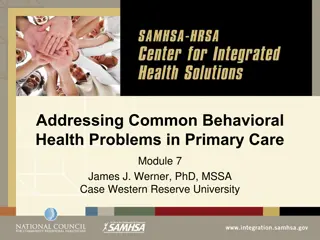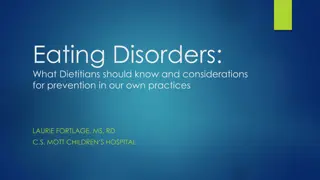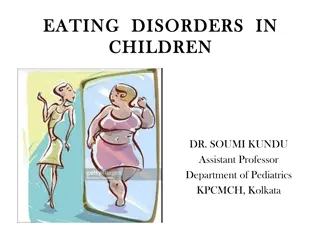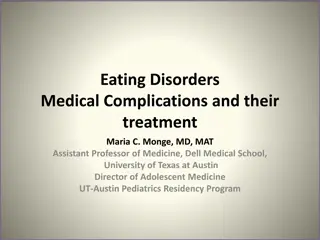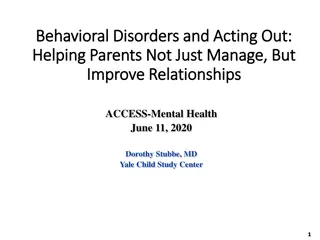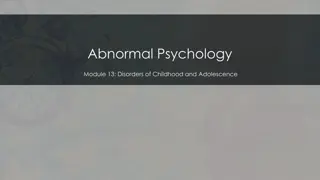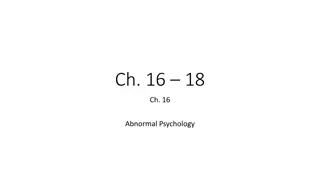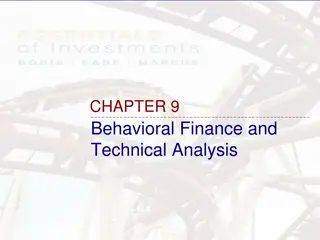Understanding Behavioral Disorders in Children
Behavioral disorders in children can result from various factors like emotional, physical, and social deprivation. These disorders manifest through a range of behaviors such as temper tantrums, bed-wetting, and aggressiveness. Identifying the causes and types of behavioral disorders is essential for effective assessment and intervention to support children's mental health and well-being.
Download Presentation

Please find below an Image/Link to download the presentation.
The content on the website is provided AS IS for your information and personal use only. It may not be sold, licensed, or shared on other websites without obtaining consent from the author. Download presentation by click this link. If you encounter any issues during the download, it is possible that the publisher has removed the file from their server.
E N D
Presentation Transcript
BEHAVIOURAL DISORDERS
introduction definition causes of behavioural disorders types of behavioural disorders assessment of common behavioural disorders. description of behavioural disorders conclusion
INTRODUCTION Behavioral disorders include many tension reducing activities that appear during childhood at various levels of development. Some of these habits develop through imitation from adults where as other as purposeful movement
DEFINITION When children cannot adjust to a complex environment around them, they become unable to behave in the socially acceptable way resulting in exhibition of peculiar behaviours and this is called as behavioural problems.
CAUSES OF BEHAVIORAL DISORDERS Faulty Parental Attitude Inadequate Family Environment Mentally and Physically Sick or Handicapped Conditions Influence of Social Relationship Influence of Mass Media Influence of Social Change
TYPES OF BEHAVIORAL PROBLEMS IN CHILDREN Behavioural disorder results due to deprivation in the following area:- 1. Emotional Deprivation 2. Physical Deprivation 3. Social Deprivation 4. Other forms
EMOTIONAL DEPRIVATION It occurs when a child is criticized, neglected, ignored or abused by primary caregiver. 1. Temper tantrum 2. Breath holding spells 3. Jealousy 4. Insomnia 5. Nightmares / night terrors 6. Somnolence 7. Bruxism 8. Masturbation or Homosexuality
PHYSICAL DEPRIVATION A physically deprived child may develop:- 1. Enuresis (Bed wetting) 2. Encopresis 3. Thumb Sucking 4. Tics 5. Nail Biting 6. Pica 7. ADHD
SOCIAL DEPRIVATION It is the reduction of culturally normal interaction between individual and society: 1. Juvenile Delinquency 2. School Phobia 3. Stealing 4. Repeated Failures 5. Lying 6. Aggressiveness/Destructiveness
OTHER FORMS 1. Speech Disorder 2. Sibling Rivalry
ASSESSMENT OF COMMON BEHAVIORAL PROBLEMS Assess whether child is happy or difficult to manage Child s response to new situation Excessive demand of attention Problems of toilet and bladder Habit of nail biting, thumb sucking, pica etc.
1. TEMPERTANTRUM Temper tantrum is a sudden outburst or violent display of anger, frustration and bad temper as physical aggression or resistance such as rigid body, biting, kicking, throwing objects, hitting, crying, rolling on floor, screaming loudly, banging limbs, etc.
SYMPTOMS Loud cry Shouting Kicking Biting Head Banging Screaming Throwing and breaking objects Inflicting self injury
MANAGEMENT Support the child and protect from self harm. Take away the child from immediate cause in a calm and quiet way. Wash the face and hands of child and change clothes. Educate the child about acceptable behaviour and give toys and emphasize on play therapy.
2. BREATH HOLDING SPELLS. brief periods for which young children stop breathing for 1 minute. often causes a child to lose consciousness Two types: Cyanotic Spell - It is caused by a change in child s usual breathing pattern, usually in response to feeling angry or frustrated Pallid Spell - It is caused by slowing of child s heart rate usually in response to pain
SIGNS AND SYMPTOMS Fainting Stiff body Too fast or too hard breath Long pause before child takes another breath Red or blue purple lips Intense/single or no cry at all
MANAGEMENT During the episode, make the child lay down on floor and prevent his/her arms or legs from hitting any sharp object. After the episode, child starts breathing immediately after 1 min. But if the child does not breathes then call emergency. Give plenty of rest.
3. JEALOUSY Jealousy is a normal response to actual, supposed or threatened loss of affection. e.g. the birth of an additional family member SYMPTOMS 1. Aggressive nature 2. Roughly handling of new baby 3. Children may act naughty to get attention 4. Gets detached or becomes over affectionate
MANAGEMENT Never punish the child for his feeling of jealousy Teach the child to deal effectively with his emotions Parents should treat child equally and avoid comparison Professional help can be taken in complicated cases
4. SOMNILOQUY a sleep disorder that refers to talking aloud while asleep, ranging from simple mumbling sounds to loud shouts. SYMPTOMS Talking irregularly and giving gaps like normal conversation. Giving good facial expressions in sleep
MANAGEMENT Sleep along with the child and assure that parents are with him/her. Satisfy the child s needs. Resolve conflicts with other children. Try to make good relationship with child. Do not show movie or tell story before sleeping.
6. SOMNABULISM a phenomenon of sleep and wakefulness combined, sleep walking occurs at a state of low consciousness and child performs activities that are usually performed in full consciousness. SYMPTOMS Sitting up in the bed. Walking to the bathroom and cleaning it. Initiating hazardous activities like cooking, driving and grabbing hallucinated objects. Homicide
MANAGEMENT Lock the doors and windows of the room in which child is sleeping. Remove all dangerous and hazardous objects, Give small dose of Diazepam in severe cases. Consult physician in uncontrollable cases.
7. NIGHTMARES AND NIGHT TERRORS NIGHTMARES:- the child gets awakened due to a frightening bad dream but the child is conscious about the surrounding. NIGHT TERRORS:- the child gets awakened during sleep and sits up screaming and terrified to recognize the surrounding & after sometime sleeps again.
SYMPTOMS Child suddenly awakes during sleep periods Child gets frightened and may not be fully alert Child describes frightening dreams in detail He/she seeks and responds to comfort given by parents. May resist return to bed because of fear of recurrence.
MANAGEMENT Give reassurance by holding him/her Speak in very soothing tone that there is nothing wrong. Discuss the dream images with the child and work together to change the outcome Let child to go to bed in same time daily Avoid scary books or movies at night
8. INSOMNIA It is a sleep disturbance in which children have trouble falling asleep or staying asleep at night. SYMPTOMS Decreased attention span Mood swings Irritability Being sleepy during the day. Difficulty falling asleep or staying asleep or waking up too early in morning.
MANAGEMENT Provide deep breathing, positive mental imaginary while lying in bed and other relaxation technique. Set bedtime to obtain usual timing of sleep. Provide a comfortable sleep environment.
9. BRUXISM It is excessive grinding or clenching of teeth while sleeping which is not related to normal function of eating or talking. SYMPTOMS Excessive teeth wear. Tooth fractures Hypersensitive teeth Grinding or tapping noise during sleep Cheek/lip biting Tenderness, pain or muscle fatigue Headache particularly in temples MANAGEMENT Repairing of damaged teeth. Dental restoration like crown filling.
10. MASTURBATION AND HOMOSEXUALITY (not disorders in the latest classification) Masturbation:- It is the stimulation and manipulation of one s own genitals in order to achieve pleasure / orgasm. Homosexuality:- It is the sexual attraction between the members of same sex or gender. These behaviours may interfere with normal living of the children, which requires help
MANAGEMENT Parents should not scold or show negative attitude towards child s behaviour. Advice and educate the child in a non threatening way about acceptable behaviour in public. As intellectual development progresses incidence of masturbation declines
DISORDERS CAUSED BY PHYSICAL DEPRIVATION 1. ENURESIS bed wetting after the age of 5, a common pediatric problem of repeated involuntary urination at an age in which voluntary bladder control should have established. PRIMARY ENURESIS :- In this child is never dry at night and occurs as a result of rigid bladder training by parents who are over anxious. SECONDARY ENURESIS :- It is characterized by initial control of bladder that later gets disrupted by stressful environment.
SYMPTOMS Repeated voiding of urine into bed or clothes. Soiling themselves. MANAGEMENT Reward the child for dry nights Wake up the child once or twice at night to void Do not give strict bladder and bowel training Make the child void before going to bed Do not give excess fluid to child after 6-7 pm
2. ENCOPRESIS repeated voluntary or involuntary passage of feces of normal or near normal consistency in places not appropriate for that purpose. CAUSES 1. Psychosocial stress like entering new school 2. Child with emotional problem 3. Subconscious anger MANAGEMENT Give family counselling about the problem. Provide minerals and vitamins if deficiency occurs. Educate parents that toilet training is a developmental process which happens in time. Do not give too strict toilet training.
3. TICS a nonvoluntary body movement or vocal sound made repeatedly or suddenly. a manifestation of discharge of tension. Simple tics involves only few muscles or sounds that are not words (nose wrinkling, facial grimace, jerking the neck and shrugging the shoulders. Complex tics involves multiple group or muscles or complete words or sentences (same motions with hands repeatedly, touching or smelling an object repeatedly and holding body in unusual position)
Sensory tics repeated unwanted or uncomfortable sensation arise (repeated feeling of blinking the eyes) Phantom tics the least common type where out of body variation takes place and the person feels a sensation in other people or object (experience relief by touching or scratching the object involved) MANAGEMENT To be ignored by caregivers Allow the child to discuss concerns related to school and family. Refer child for medical evaluation if tic does not decrease
5. NAIL BITING a common habit of childhood an overt evidence of anxiety in older children thumb suckers change to nail biters as they grow older SYMPTOMS Biting nails of all the fingers. The cuticle, skin margins, and surrounding tissue of the nail gets affected. Nail cutting is painful and the child may use this as a form of self punishment.
MANAGEMENT Assess the psychological environment of the child Do not scold or punish the child for it Use a bitter substance applied for nails Keep child s hand soft by applying lotion or warm oil
6. PICA eating substances other than food (clay, sand, plaster from walls) frequent in first year of life but may be seen in grown ups SYMPTOMS 1. Lack of appetite 2. Lots of hair collection in stomach 3. Intestinal and parasitic infection 4. Minerals and vitamin deficiencies MANAGEMENT Proper supervision of parents Provide psychotherapy Provide treatment of worm infestations
7. THUMB SUCKING Sucking is the infant s chief pleasure through which they get love, affection and satisfaction. Infants do thumb sucking if they lack oral satisfaction. CAUSES Sign of boredom, stress and isolation Lack of bonding between parent and child Manifestation of feeling of insecurity Infants deprived of sucking and breast feeding
MANAGEMENT Mother should fulfill the need for sucking by allowing for breastfeed. Always praise and encourage the child which helps to give up thumb sucking. Parents should not show anxiety till the child is 4 years old
Disorders caused by social deprivation 1. JUVENILE DELIQUENCY defined as an individual under the age of 16 who fails to abide by the laws. Characteristics of juvenile delinquency: The behaviour is marked by violation of law, persistent mischievousness, antisocial behaviour, disobedience etc.
Interventions Family should act as role model and support their children juvenile correction homes provide safety and supervision of delinquent children Juvenile justice board seeks to provide protection and safety of public and of the minors who have come in contact with court. Conclusion Behaviour disorders are tension reducing activities that appear during childhood education to parents is a part of this process which help parents to guide their children
2. SCHOOL PHOBIA Definition School phobia is also known as school refusal or school avoidance Children who resist going to school or who demonstrate extreme refusal to attend school for a sustained period of time are said to have school phobia. They demonstrate signs like leg pain, headache, nausea, vomiting etc.
MANAGEMENT Treatment depends upon the cause Examine the relationship of child with teachers and with the peer group Reward the children for going to school on daily basis Professional child consultation in severe problem
OTHER DISORDERS SPEECH PROBLEMS Stuttering or stammering a fluency disorder beginning between 3-5 years probably due to inability to adjust with stress characterized by interruptions in the flow of speech, hesitations, spasmodic repetitions etc.
Cluttering Cluttering is characterized by unclear and hurried speech in which words tremble over each other. These are awkward movement of hand feet and body. Distalia the disorder of difficulty in articulation which is caused by abnormalities in jaw and palate
MANAGEMENT Speech disorders are managed by: Behaviour modification and relaxation therapy. Reassure the child and help in breath control exercise. Speech therapy Common points of managing behaviour disorders Discipline the child Behaviour modification Strategy of ignoring
Thank you Thank you





